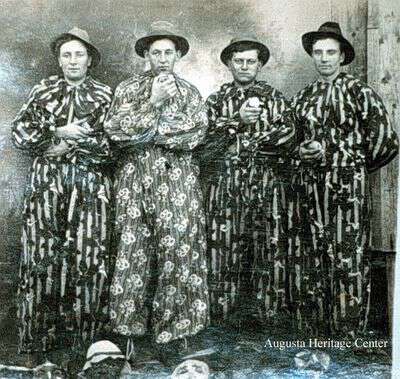Everyone knows about Santa, but have you heard of belsnickels?
The winter solstice has long been a time for festivities and seasonal activities. Many traditions trace back to European immigrants in early America and some of these traditions still exist in West Virginia.
When European settlers arrived in Pennsylvania in the 17th century, they brought “mumming” or masking traditions with them. Generally mumming traditions reference sacrifice and rebirth and possess an element of ritual disorder. Mumming traditions include Halloween, Fastnacht, Mardi Gras, Saturnalia, and they typically take place between October and the spring. Halloween is probably the most pervasive of these traditions, and involves “begging”, a common mumming trope. Since the post-Civil War era, Lewisburg, WV has been home to another type of mumming parade called shanghai. Folklorist Gerry Milnes has linked the name shanghai to a “Gaelic term ‘sean aghaidh’ meaning ‘old face,’ and relating to the masquerade that is essential to the practice” (Play of a Fiddle, 17).
As German and Scots-Irish settlers spread out, mumming traditions trickled into the mountains of West Virginia. Belsnickling was a holiday tradition that took root in German and Pennsylvania Dutch communities and was later fostered in West Virginia. The tradition highlighted a central character, the belsnickle, who dressed in a disguise. The goal was to make one’s identity indistinguishable to their community oftentimes with masks.

You might be familiar with belsnickels from an episode of The Office, in which the character Dwight (Rainn Wilson) dresses up as a belsnickel for an office holiday party. Belsnickels perform both begging and mumming practices by donning a disguise and going from door to door. Usually on Christmas Eve, costume-clad belsnickels go from house to house, and residents guess the belsnicklers’ identities. Belsnickels were often rewarded for their clever disguises with food and libations from the house. The word comes from the German belsnickle, a midwinter elf who represents a dark contrast from jolly St. Nicholas. In some instances, belsnickels like Santa punished misbehaving children. Unlike Santa’s gift of coal, belsnickels carried switches. If they encountered children, the belsnickels would toss candy on the floor and switch the kids’ fingers if they grabbed for the candy too quickly (see audio below).
The practice of belsnickling was common in West Virginia, especially in more rural parts like Pendleton County, into the mid 20th century until fewer and fewer people welcomed masked figures into their homes. Belsnickels were admittedly rowdy and raucous and as crime became more publicized with news media, people became less inclined to invite belsnickels into their home. The tradition was also curbed by conservative Christians and Mennonites who were averse to its allegedly pagan roots. Halloween is opposed by sects of Christians for the same reason.
These traditions represent attempts to drive out the evil or the old and foster hope for the new year. Mumming traditions like belsnickling gave adults and teenagers the chance to experience the excitement, camaraderie, and ritual disorder that kids still often participate in during Halloween. They connect us to the early traditions planted here by immigrants and give a glimpse into how people connected to their communities and spiritual beliefs during the winter solstice.
If you want to learn more, check out this Augusta cultural session on mumming traditions: https://youtu.be/qsT_4TUY5W8


Wonderful !!!